11+ Sample Teacher Recommendation Letters
-
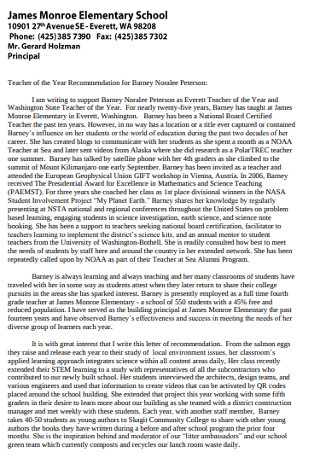
Elementary School Teacher Recommendation Letter
-
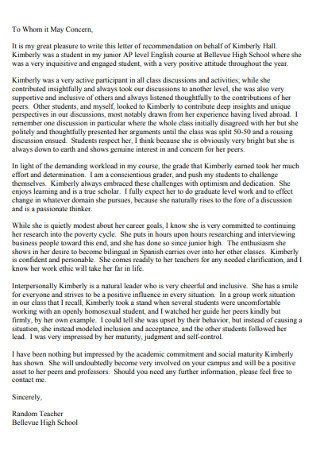
High School Teacher Recommendation Letter
-
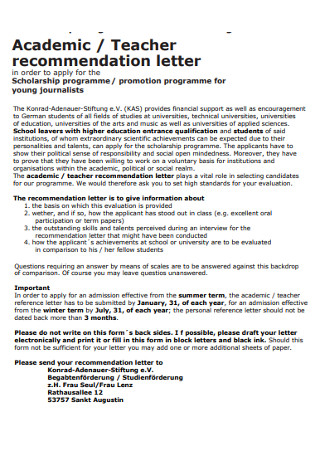
Academic Teacher Recommendation Letter
-
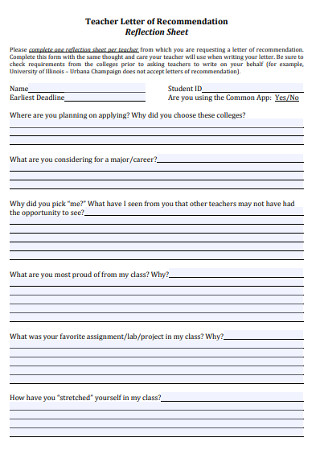
Teacher Letter of Recommendation Reflection Sheet
-
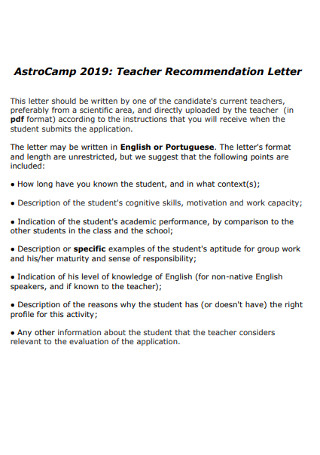
Simple Teacher Recommendation Letter
-
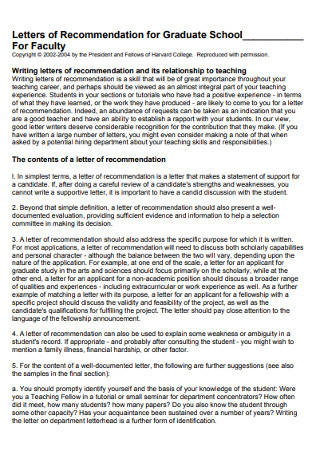
Graduate School Teacher Recommendation Letter
-
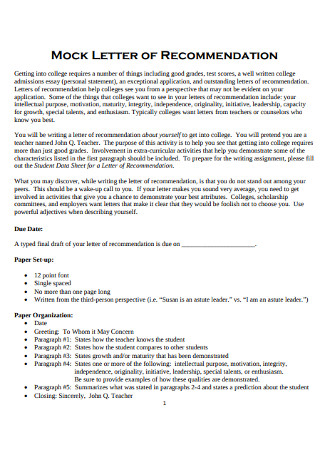
Basic Teacher Recommendation Letter
-
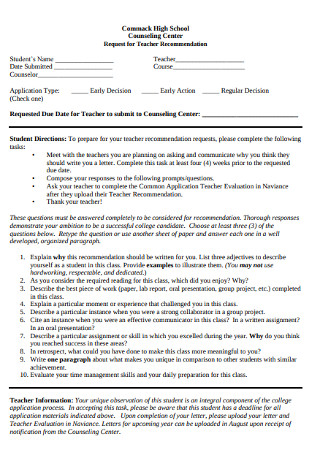
Counsilling Center Teacher Recommendation Letter
-
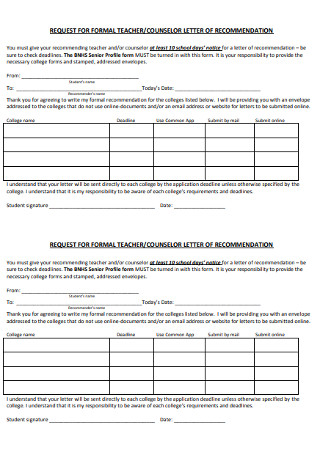
Formal Teacher Recommendation Letter
-
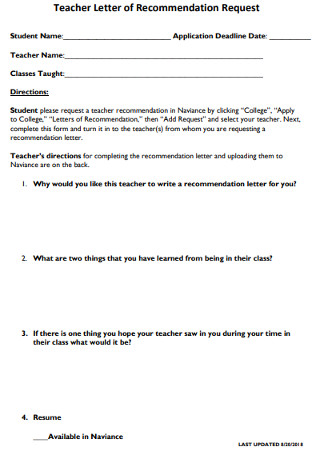
Printable Teacher Letter of Recommendation
-
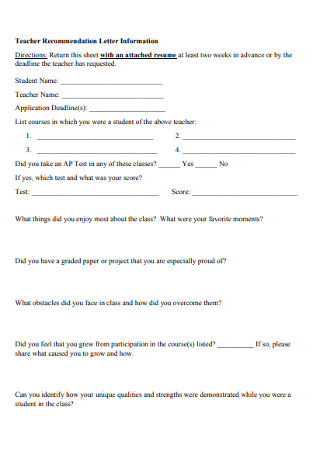
Teacher Recommendation Information Letter
-
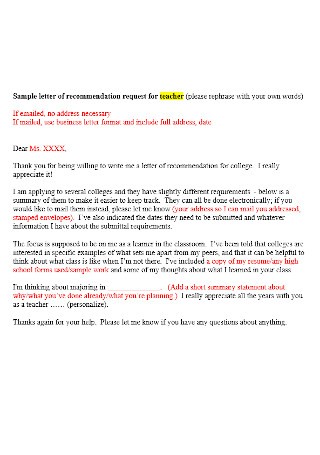
Thank You Teacher Recommendation Letter
download now
FREE Teacher Recommendation Letter s to Download
11+ Sample Teacher Recommendation Letters
What Is a Teacher Recommendation Letter?
Importance of a Teacher Recommendation Letter
Elements of a Teacher Recommendation Letter
How to Write a Teacher Recommendation Letter
The Dos and Don’ts of a Teacher Recommendation Letter
Below are handpicked, high-quality teacher recommendation letter examples and templates that you can download and use at your own disposal. Do not miss the opportunity to download and customize any of these today!
What Is a Teacher Recommendation Letter?
A teacher recommendation letter is a document that may be asked of you to write by a teacher who seeks employment in the academe and uses this for their job application. It must effectively list down the qualifications and character traits of the candidate, both as an individual and as an educator, that increases their chances of getting hired. The letter must not exceed more than one page and should be quick and easy to read. Ideally, this type of letter should be written by the principal, department head, or a fellow educator from the applicant’s previous employment. For applicants with no experience, having a former professor write it would be ideal.

Importance of a Teacher Recommendation Letter
As mentioned, teaching is a competitive field. This remains true despite the projection of the U.S. Bureau of Labor Statistics (BLS) that there will be 1.9 million job opportunities for those with teaching careers for preschool to postsecondary school between 2014 and 2024. However, the problem with filling job vacancies is not because of unqualified applicants?there are existing hiring policies that make it difficult for would-be educators to start teaching in classrooms. With that said, most job applicants seeking for job positions in the academe find the need to look for ways on how they can stand out among other applicants. This is when the role of a teacher recommendation letter enters.
A teacher recommendation letter successfully validates what the hiring manager or employer has read or learned from the cover letter and resume of the applicant. This letter provides the answers to the questions hiring managers or employers generated regarding their performance from their previous employment. If the recommendation letter has been written with all honesty, rest assured that the candidate will get a well-deserved result.
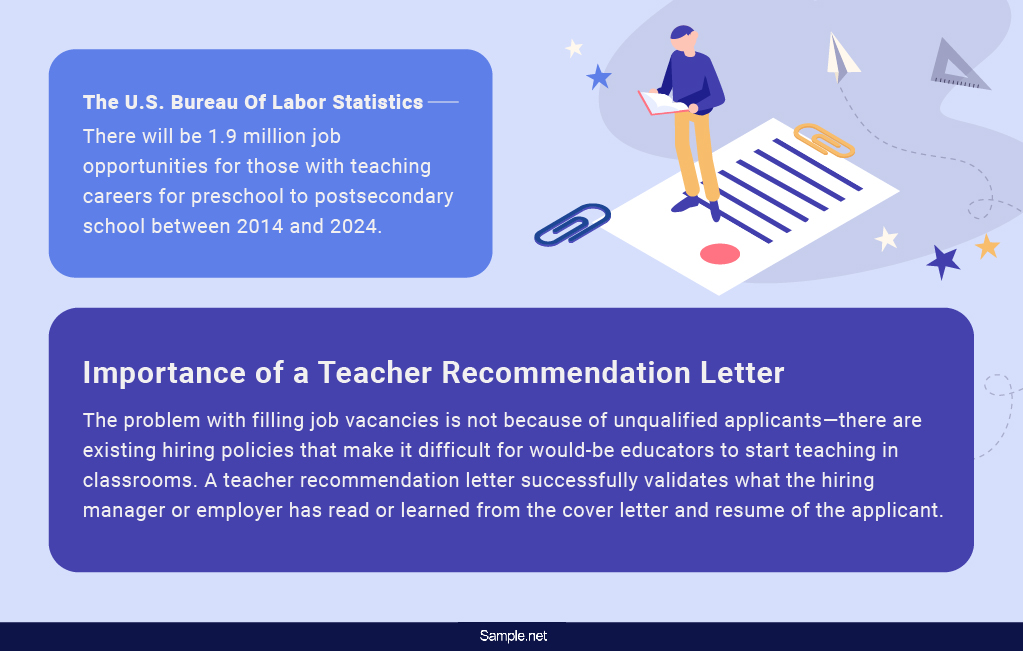
Elements of a Teacher Recommendation Letter
To compose an effective teacher recommendation letter, you need to ensure that it contains all the necessary and required elements. Below are the must-have items that must be found in the teacher recommendation letter you are about to write.
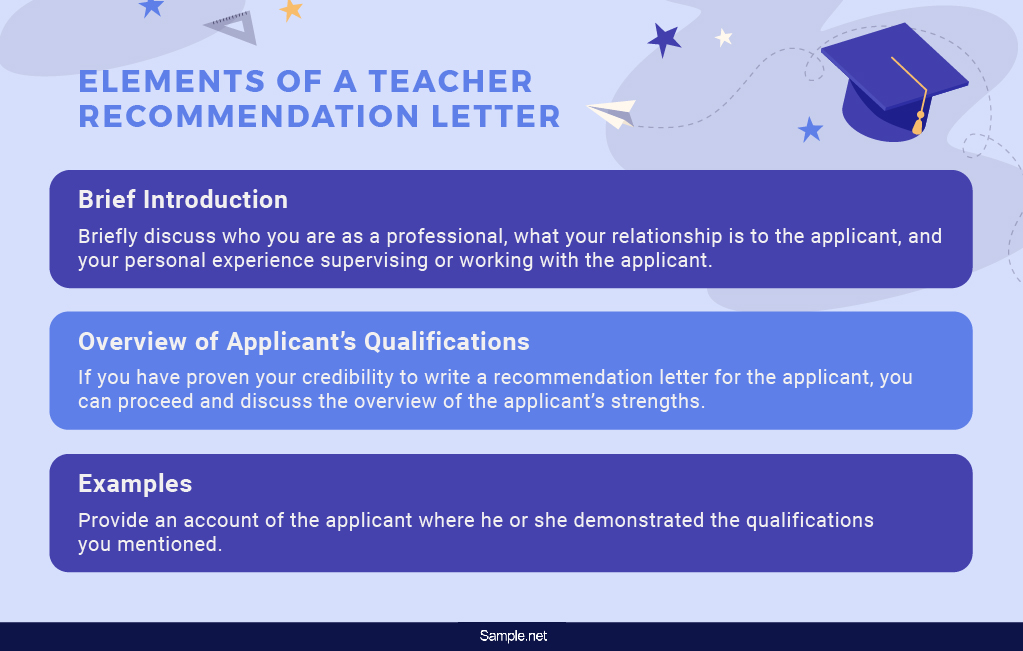
How to Write a Teacher Recommendation Letter
A teacher recommendation letter is structured in a way that you can list down the accomplishments of the applicant, your relationship with them, and the attributes that make them worth considering for the teaching position. However, to ensure that the entire contents of your letter are successfully written and formatted, see to it that you are following the steps below to keep you guided.
Step 1: Download a Ready-Made Letter Template
While you can possibly start writing a recommendation letter from scratch, you can just download a ready-made letter template. By doing so, you can use it as it is. All you have to do is simply replace all text placeholders with your personalized content or customize it according to any specific instructions and it’s most likely good to go. You can also make use of it as a guide when formatting and laying out a recommendation letter from scratch.
Step 2: Start with the Basics of Business Letter
A teacher recommendation letter of recommendation is a type of business letter and as with any letter, you need to secure the basic information written before you get to write the body of the letter. The basics include your name, title, address, and contact details as the heading address, the date when the letter was written, and the inside address that contains the name, title, and address of the receiving end.
Step 3: Introduce Yourself and State Your Qualifications
After a simple greeting to the hiring manager or employer, you need to formally introduce yourself first by stating your current role and qualifications. In that way, the hiring manager will know whether or not you are qualified and credible enough to write a recommendation letter for the applicant. You may answer the basic Wh- questions for this part of the letter, such as when and where you worked with the applicant. It is also important to indicate how long you have known or worked with the applicant to further strengthen your credibility.
Ideally, a teacher recommendation letter should be written by someone who is in a position who may have previously supervised or worked with the candidate such as a principal, department head, or a fellow educator.
Step 4: Discuss the Subject’s Qualifications
Write the information you want to include in the letter that states your purpose for writing and make sure that whatever information you are planning to input can help the candidate’s chances of getting hired. Mention relevant qualifications fitting to the job description. Other than the teacher’s hard skills, make sure that you also highlight their soft skills such as their sense of leadership and good communication skills.
Consider discussing this part with the candidate in case they can provide you with an outline of things to discuss so you will know how to compose a letter that enables you to highlight the skills and capabilities that would help them emerge as the best from a pool of applicants.
Step 5: Cite Specific Examples to Illustrate the Applicant’s Skills
If you want to discuss things direct to the point, you can skip this step. However, it is worth considering to cite concrete examples that illustrate the aforementioned qualifications for the job. Citing examples does not have to take up too much of the page. You may cite an example that proves that the applicant possesses certain relevant hard skills in one sentence and another for their soft skills. However, you can definitely merge the two and with the right combination, it is possible for you to present the applicant in a way that makes them the best out of all the other qualified applicants.
Step 6: Encourage Further Communication
Before concluding the recommendation letter, express your willingness to further verify what you wrote in the recommendation letter and discuss matters about the subject by providing your working contact number or active email address. There are hiring managers who would really go out of their way to make a thorough background check. This is also beneficial on your end, especially if there are things you forgot to include in the letter or if there are matters you want to expound further that didn’t make it to the final draft.
Step 7: Proofread and Edit
Be a professional and do not send an unedited job recommendation letter. See to it that before you print your final draft, you already took some time to proofread and edit it. If time allows, take a break first and come back to reread the letter with a fresher perspective. Do not only look out for typographical errors and grammatical mistakes but also be sure to check the correctness and completeness of every single piece of information that you input.
The Dos and Don’ts of a Teacher Recommendation Letter
A teacher recommendation letter shouldn’t be too daunting to write. But in case you have little to no experience in writing one, you should take some notes from the following dos and don’ts in order to be guided.
Dos
1. Do follow a formal or business letter format.
When you use a business letter format, expect that employers or hiring managers will more likely have a positive response. A letter of recommendation is a type of a formal or business letter; hence, it’s only customary to use the standard format of a business letter. Regardless of the candidate’s qualifications and characteristics, it should always follow the same format all throughout, starting with the return address, followed by the date, the inside address, salutation, introductory paragraph, supporting paragraph, concluding paragraph, closing remarks, and signature.
2. Do make the job description a focal point.
Avoid straying away from the topic. Make it a point to solely focus on the job description of the vacant teaching position. It is ideal to ask for a copy of the job description to know the general tasks, related duties, and responsibilities required by the position. For example, if the institution is seeking someone who can cultivate a hunger or thirst for knowledge among the students, make sure to include a statement regarding that in the letter especially if the applicant is qualified.
3. Do incorporate related examples.
To strengthen your claims about the applicant, it is best to back it up with specific examples and quantify their milestones in which the applicant showed traits and actions that prove your statement about them. For example, you can state that with the help of the applicants’ teaching prowess, the candidate was able to improve the performance of Math students by 25 percent.
4. Do know your qualifications.
Before you accept an applicant’s request for a recommendation, you must know if you are qualified. Have you worked with and directly supervised the candidate? Can you attest to the strengths and skills the candidate listed on their resume and cover letter? Do you have concrete examples to cite? Can you give factual positive feedback about the candidate? If you know you are not experienced or knowledgeable enough about the candidate, be sure to inform them ahead of time so they can find an alternative.
5. Do keep a positive tone.
Even if you have to be honest in how you present the candidate’s qualifications in writing, maintain a professional and positive tone throughout the content of the letter. You can further help the candidate to emerge as the best out of the best by simply sticking to a positive tone when writing the recommendation letter.
6. Do follow the submission guidelines.
During your talk with the person for whom you are writing the letter whether or not submission guidelines were provided by the hiring manager. Know whether the letter should be emailed or uploaded online. Determine where and when to send it. Follow any requirements cited such as the file format. Failure to follow it or to even ask about this with the applicant will only decrease their chances of getting their application considered.
Don’ts
1. Don’t encourage a word-for-word dictation.
If you find the time to discuss with the applicant before you get to write the recommendation letter, all you can do is accept an outline of the letter’s flow. What you should not accept is a word-for-word dictation as to what you should write in the recommendation letter. This is for the welfare of the applicant?if ever such dirty and dishonest tactic gets discovered, the applicant loses the chance to get hired for the teaching position. It is not only the applicant’s integrity and credibility that is put at stake, but it also includes yours since you allowed such a thing to happen.
2. Don’t exceed more than a single page.
Just like the teacher’s resume and cover letter, the length of a recommendation letter should be one page at most. A letter that has a lengthy content will not look good in the eyes of any hiring manager. With all the applications they get to deal with every single day, they will most likely just skim and scan any document they receive. Keep things safe by only incorporating relevant matters to discuss. If the subject has too many qualifications that you can possibly mention, stick to at least one or two characteristics you think are advantageous to the applicant’s chances of getting hired. Cut out whatever is unnecessary so you can focus on what really matters.
3. Do not forget to proofread.
To make any document error-free, taking some time to proofread will do the trick. When writing any letter, everyone is prone to making typographical errors, grammatical mistakes, and writing inaccurate information. If you think you have everything thoroughly checked, just wait until you take some off from it and get back to it later. With a fresher perspective, you can surely notice the mistakes you’ve made that were not too glaring before you took a break or asked someone to run it through for you.
While it would be an honor if someone applying for a teaching position asks you to write a letter of recommendation, one cannot deny the fact that it can be a challenging task to fulfill. But since you are now equipped with the basic knowledge about its definition, elements, importance, and the steps on how to make one, rest assured that you can already write a recommendation letter that can indeed land an applicant in a teaching job position. To further guide you, be sure to download the recommendation letter templates and examples provided above. You can either use these templates as it is or use these examples as a reference.
